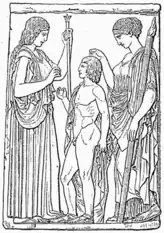| Great Eleusinian Relief | |
|---|---|
| Greek: Ανάγλυφο Ελευσινίων Μυστηρίων | |
.jpg.webp) The marble relief in the NAMA | |
| Completion date | c. 430-420 BC |
| Catalogue | No 126 |
| Medium | Marble |
| Movement | Early Classical |
| Subject | Demeter and Persephone bless Triptolemus |
| Dimensions | 220 cm × 152 cm (87 in × 60 in) |
| Condition | Intact |
| Location | National Archaeological Museum, Athens |
| Owner | Greece |
| Website | https://www.namuseum.gr |
The Great Eleusinian Relief (Greek: Μεγάλο Ανάγλυφο Ελευσινίων Μυστηρίων) is a large marble relief kept in the National Archaeological Museum, Athens in Greece. It depicts a scene of the Eleusinian Mysteries with the principal deities, Demeter, Persephone and the hero Triptolemus.
History
The relief has been dated to mid-fifth century BC, around 430-420 BC, and it was made for religious use, rather than votive as evidenced from the numerous Roman copies created during the Roman period.[1][2] It was discovered in Eleusis in 1859 at the sanctuary of Demeter,[3] near a church dedicated to Saint Zacharias.[4]
Description
The relief is made of Pentelic marble, and it is 2,20 m. tall, 1,52 m. wide, and 15 cm thick.[4] It depicts the three most important figures of the Eleusianian Mysteries; the goddess of agriculture and abundance Demeter, her daughter Persephone queen of the Underworld and the Eleusinian hero Triptolemus, the son of Queen Metanira,[3][4] in what appears to be a rite.[1] Triptolemus stands in the center, the two goddesses surrounding him on the left and right.
The goddess on the left is dressed in a leg-length sleeveless chiton and himation (a type of cloak), holds a sceptre in her left hand, while with her right one she hands Triptolemus some unidentified object made of copper, probably ears of corn.[4][1] The child Triptolemus reaches to receive the goddess's gift with his right hand, while holding his robe with his left.[2] The goddess on the right rests her weight her right leg, and wears a foot-long chiton and a rich pleated himation.[5][1] In her left hand she holds a large torch reaching the ground, while with her right she touches the head of Triptolemus, perhaps originally holding some sort of wreath,[5] or blessing the boy.[1][2] It is generally accepted that the goddess on the left is Demeter and the one in the right is Persephone,[3] but arguments for the opposite have also been expressed. Namely, it has been noted that the right figure is dressed more lightly like a maiden, whereas the right figure sports the rich garments suitable for an older woman.[5]
Copies
The original relief had several copies made of it during Roman times, many of which survive; a copy of it is kept at the Metropolitan Museum of Art in New York City, embedded from ten Roman fragments of the first century BC and the first century AD.[3]
Gallery
- Great Eleusinian Relief
 Roman copy in the MET.
Roman copy in the MET. Engraving of the relief.
Engraving of the relief.
See also
References
- 1 2 3 4 5 Kaltsas 2007, pp. 310–311.
- 1 2 3 "Μεγάλο Ελευσινιακό ανάγλυφο" [Great Eleusinian Relief]. odysseus.culture.gr (in Greek). Retrieved December 8, 2023.
- 1 2 3 4 "Ten marble fragments of the Great Eleusinian Relief". www.metmuseum.org. Retrieved December 5, 2023.
- 1 2 3 4 Kavvadias 1890, p. 119.
- 1 2 3 Kavvadias 1890, p. 120.
Bibliography
- Kavvadias, Panagiotis (1890). Γλυπτά του Εθνικού Μουσείου [Sculptures of the National Museum] (in Greek). Athens, Greece: S. K. Vlastos.
- Kaltsas, Nikolaos (2007). Εθνικό Αρχαιολογικό Μουσείο [National Archaeological Museum] (PDF) (in Greek). Athens, Greece: OLKOS. ISBN 978-960-89339-1-0.
External links
 Media related to Great Eleusinian Relief at Wikimedia Commons
Media related to Great Eleusinian Relief at Wikimedia Commons
